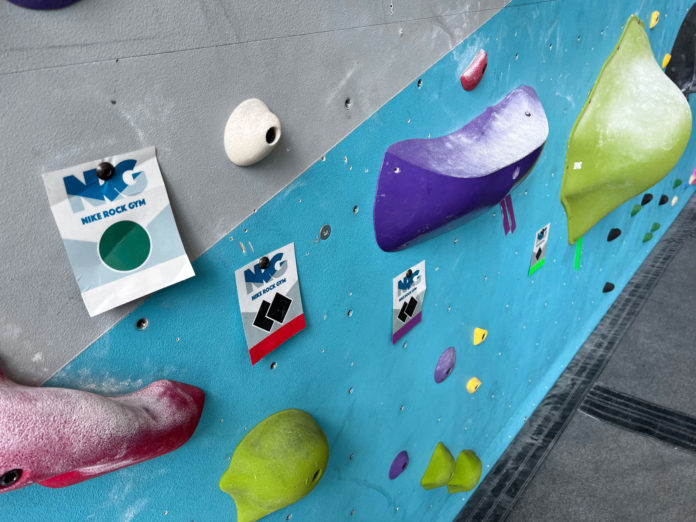Behind the Impact is a series that explores current routesetting topics in conversation with the head routesetters of the industry. In this second installment, Devin Dabney catches up with longtime friend James Mower about circuit-style grading and how elements of it can be used to increase your gym’s customer base, as well as create more members.
Want more routesetting content? Be sure to check out our Ask a Setter and Behind the Wrench series as well.
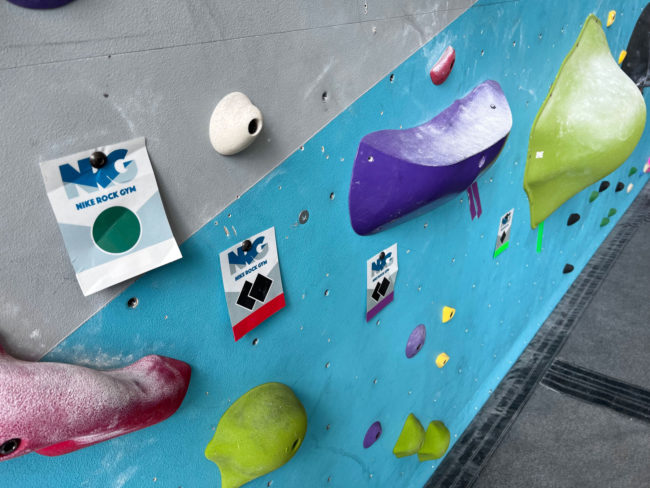
As mentioned in my previous article about the RIC Scale, grades have always been an interesting topic in the climbing world—and for good reason. Climbing is one of the few sports that uses a subjective system for our challenge ratings and, as climbing develops, that subjectivity’s range only seems to widen—especially as gyms try to standardize their own climbing grades. The circuit system is one of those standardization methods—one that already has a lengthy history in outdoor grading, and is becoming increasingly common in climbing gyms.
While a gym’s grading system may seem like a trivial choice, it has a larger impact than one may realize. It undoubtedly affects the community of climbers, but I would even argue that making the proper grading system choice could benefit a climbing gym’s business. But, for which gyms does it make sense to use circuit-style grading? It has become more noticeably popular in climbing gyms, but is it truly the best solution for every gym? How does one know whether circuit-style or traditional grading is the best choice for their climbing community?
As I will detail below, I believe this does not have to be a binary choice. For a commercial gym, it’s not a matter of saying ‘yes or no’ to circuit grading, but instead ‘to what degree,’ and ‘how can this help my climbing community (and business) grow?’ While there are elements of this system that can benefit almost any climbing gym, their usage will vary for each gym depending on its customer base and mission as a business. These are the variables I will attempt to answer in this article, with the help of my longtime setting colleague, James Mower.
I couldn’t think of a better person to talk grading systems with than James. This is not just because of his long rap sheet of experience with comps, gyms and collegiate settings, but also because he’s the person I’ve worked with the most in setting environments, so we’ve already had a lot of discussions about grades. When I moved to Portland, Oregon, in 2018, James was my boss at the Nike Rock Gym (NRG) and my co-worker at Movement PDX (then Planet Granite Portland); we would also go on to set together at a local athletic club and at several comps—that is, when we weren’t climbing at Leavenworth or the other local gyms. Furthermore, we spent several years immersed in both grading systems at our jobs; Movement used traditional numbers, and the NRG had a grading circuit.
First, let’s discuss the basics of circuits and how they work.
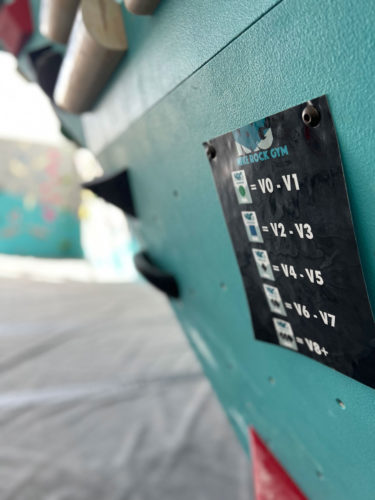
What Is Circuit-Style Grading?
James Mower describes circuit-style grading as “creating categories of difficulties that climbers will experience, rather than utilizing more specific grades…Circuit-style grading broadens the scope of difficulty through wide ranges and/or overlapping grades.” Rather than just using a traditional scale such as the YDS or Hueco scale, climbs are labeled in chosen difficulty ranges—oftentimes with color (i.e. red = V0-V2, blue = V2-V4, etc.); the number grade may also be displayed on each climb’s tag, though it oftentimes isn’t. These groupings of climbs are known as “circuits”—the system’s namesake—and it’s worth noting that while gyms typically create circuits based on difficulty, they can be organized by any unifying trait, such as climbs with similar holds, styles or setters.
While this system does provide a standard of sorts, its parameters are entirely malleable, which helps make it perfectly suited to any unique climbing gym. I’ve detailed the main parameters of circuits below, which can be adjusted based on the skill and experience levels of a gym’s customer base. I will use V-grades for my examples, but please note that circuits can also be used for roped climbing grading.
Range
This refers to how many grades are encompassed in each circuit; for example, if your grade range is two, that means two V-grades comprise each level (i.e. V0-1, V2-3, etc.). This should ideally be uniform across the whole circuit so your climbers can easily remember it. Additionally, some gyms will leave the hardest range open-ended (i.e. V8+) to allow for anything exceedingly high, though this is not usually done for outdoor areas.
Overlap
This refers to how much your circuits intersect with each other, if at all. As an example, one grade of overlap would look like V0-V2, V2-V4, etc., in which case V2 is present in two circuits. Some gyms implement overlapping grades to ease the transition between their circuits. Like with Range, Overlap should ideally be uniform across the whole system.
This, of course, means that there will be climbs that can fit into two different circuits. The decision of where to sort said problems, then, is not as simple as basing it on a proposed grade. This is where the curation aspect of circuits comes into play, as the head setter can decide which circuit these ‘crossover’ boulders fit into better, and they can ideally help smooth the transition between circuits even further. Some gyms will even call attention to crossover boulders—either by labeling them with both circuits they fit in or giving them a special label all their own—which can be especially helpful for climbers who are preparing to transition into a more challenging circuit.
Labeling
As it suggests, this is how you choose to label or denote the grade ranges in your gym. Many gyms do not label each problem with its number range, but instead will have reference charts placed in key areas while using a visual marker on specific climbs. Color is often used—usually on the tags, but some gyms like North Mass Boulder in Indianapolis, IN use the color of the climb’s holds to show its grade range. Gyms can get fairly creative with labeling; for example, my gym—the Nike Rock Gym—uses the ski slope system (i.e. green circle, blue square, black diamond, etc.). My personal favorite example of this is the Crux Climbing Center in Austin, TX which uses animals.
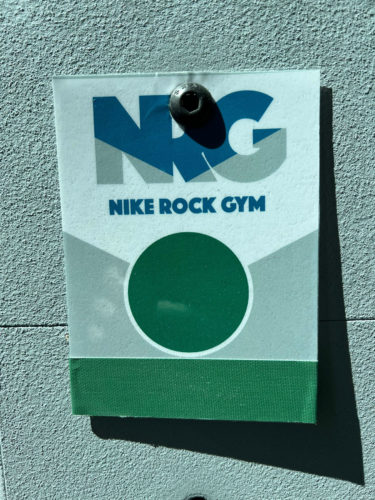
What Do Circuits Do Well?
There are many potential benefits to implementing circuit grading, not just in your customer-facing aspects but in your routesetting distribution:
1. Creates More Sustainable Climbers (and Customers)
If a new climber starts with circuit grading, their focus will tend to mirror the structure of circuits, meaning they will try as many climbs as possible in a wide range of grades. There’s generally less focus on ‘grade chasing,’ which can lead to frustration, overtraining and burnout. “Climbers look at routes or problems to try, rather than what grades to finish,” Mower said. Arguably, this behavior fosters climbers who are more likely to continue climbing long term, and thus more likely to keep coming back to your gym. James also added that having overlap in your circuits’ ranges (i.e. V1-3, V2-4) “helps climbers navigate the realm of climbing without too much pressure, and gives a clear expectation of growth.”
2. Serves More Climbers, More Efficiently
From an operations perspective, clearly separating out difficulty ranges makes it easier to see what climbs are available for your various customer bases (i.e. beginners, regulars, experts, etc.). Head setters can easily take inventory of what is on the wall and who it is serving. Additionally, circuits help mitigate tunnel vision when analyzing setting distribution, meaning that rather than ensuring there are enough V3s, the focus goes to making sure there are enough climbs for V3 climbers.
Circuits help your setting operations become more flexible and, as a result, more efficient. Less time is spent tweaking problems to hit that ‘exact’ number of V3s needed—V3s whose grades will still get argued about anyway. And as we discussed earlier, because the ranges are arbitrary, they can be set to match your customer base.
3. Fewer Arguments (and Customer Complaints)
A gym with grade circuits tends to have less debate about grades in general. In both our decade-long careers, James and I have observed that, in gyms with circuit-style grading, there are fewer grade-related disputes between setters and between customers, and far fewer customer complaints—both in the Midwest and Pacific Northwest markets in which we’ve predominately set. I believe this is because using ranges cushions against the variety of opinions around ‘exact’ number grades, thus allowing customers to focus more on enjoying the climbs as a whole while still having a general idea of their difficulty.
Keep in mind, circuits do not entirely eliminate grade arguments; those will happen regardless of what system you use, how experienced your setters are, or how much time they spend trying to grade ‘accurately,’ which I believe is a futile pursuit anyway. James and I still have experienced debates within circuit-style gyms, including on our own teams. (Oftentimes this occurs when a problem is on the upper or lower edge of a circuit’s difficulty range—yet another reason why overlapping your circuits’ grade range is a good idea.)
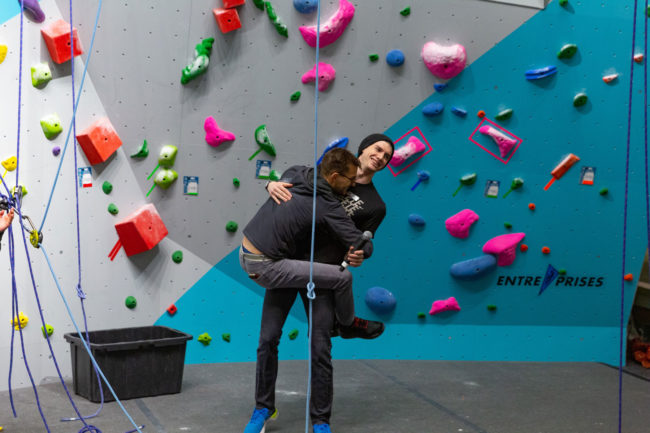
Where Are Circuits Lacking?
For the reasons above, circuits can be a very positive choice for a lot of gym environments. But there are also a few downsides to be considered and mitigated:
1. Harder to Do Workouts
“It can be hard to follow training plans in circuit-graded gyms, as many rely on knowing a more specific difficulty of the climb,” said Mower. This applies to athletes, coaches, or even a regular member who’s following a training program. I myself have watched several climber friends get frustrated with their gym’s circuit grading for this exact reason.
Similarly, it can also be frustrating for climbers experiencing a plateau, or even someone who is progressing but has been in the same circuit range for a long time; climbers can sometimes feel like they are not making progress, even if they actually are. This is why it’s generally a good practice not to make your circuit’s grade ranges too big, i.e. V2-V6; when determining your range, be sure to think about how long it will take an “average” member to progress through it.
2. Harder to Leave Comfort Zones
On a similar note, “Climbers may be intimidated to jump from one circuit range to the next due to the large increase in difficulties,” Mower said. Like with number grades, climbers easily get comfortable in their regular circuit—likely because there is so much more variety available to them without needing to branch out. It’s also worth noting that James and I found this to be true whether or not there was overlap in the circuits’ difficulty ranges. The psychological factor of ‘leveling up’ will always carry some intimidation.
3. Mitigating Risk Is (Slightly) Harder
Although climbers can choose to put themselves in unsafe situations—regardless of the grading system—not having concrete numbers can add a small amount of uncertainty to the climbing experience. Even with number grades, climbers can never be certain of what sort of challenge they’re embarking on when they engage with a climb, and circuits amplify that unknown factor. That being said, there are a multitude of easy counters to this, including 1) having grades clearly displayed on each climb, 2) having plenty of options for downclimbing, or even 3) labeling the risk level of a climb. When I frequented Portland Rock Gym in 2019, they used a chili-pepper system to label a climb’s risk level (or spiciness), regardless of grade, in which more chili peppers next to the grade meant more risk.
Climbing grades are oftentimes not the best measurement tool for risk anyway—especially because they are subjective, widely varied, and relative to each climbing location. If you’re a gym owner or manager who’s concerned about the potential risks your climbers are taking on, work with your head setter to implement strategies that best fit your climbing community.
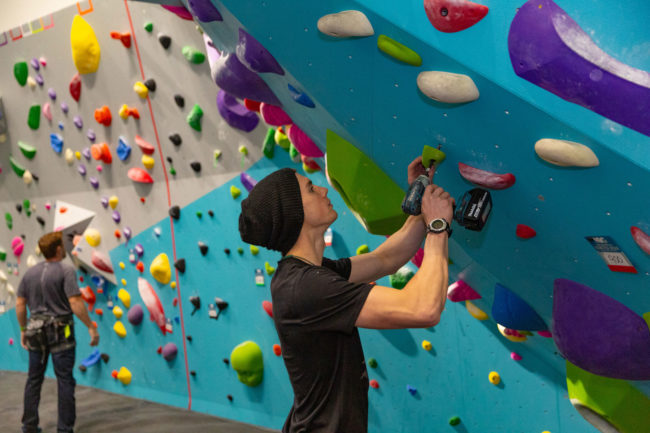
How Can a Gym Implement Circuit Grading Well?
Ultimately, James explained that because every gym environment is different, how each gym uses circuits should suit that specific environment’s needs. “There isn’t a ‘best’ option when it comes to how a gym chooses [to] grade, as it depends on the culture of the gym, the clients you wish to attract, and the full range of grades you expect to see in the gym,” he said. “I am in a unique situation where I have been both the head setter and the manager of a gym, so I was able to focus all the efforts of the gym [on] the community with the assistance of my team. In most commercial gyms, talk with your management team and ensure that you are all aligned with what the goal of the gym is.”
When setting up your circuits, it’s crucial to consider how they will interface with your customer base. Remember that the parameters you use (i.e. range, overlap and labeling) are not arbitrary choices and, combined, will play a huge role in how much your customers love—or hate—your grading system. Make sure to discuss with your setting management and, when first implementing circuits, talk frequently with your customer base to get a sense of whether they understand the system you’ve implemented. Also, keep in mind the parameters are never set in stone, and you can change them at any time―though I recommend not doing this more than once a year, as changing your system often will confuse your member base.
Are There Any Gyms That Should Avoid Circuit Grading?
When asked about how one can make the choice for their own gym, James had a lot of thoughts. “[It] comes down to the culture of the gym you wish to provide, the climbers you are serving, and what the goal of your gym is,” he answered. “If you want a culture of progression in your gym that revolves around improvement and the climbers you serve are keen on that, the specific grading model will work better…If you want a gym that is focused more on the community culture and climbers who are more interested in the sport than the grade, circuit grading is the better choice here.
“The tough part is that many gyms want to accomplish as many things as possible,” he continued. “The gym owner or management team will need to assist in understanding what their goals are and who they wish to serve, as that will assist the head routesetter in making the correct decision about what type of grading is utilized.” This is where I’d like to reiterate that it’s not an either-or choice, and that you can implement both circuits and numbers.
From a routesetting perspective, James and I agree that circuits are far better for operations, and we will always want to use them. “Circuits every time,” he voted. “My goal as a routesetter is to create complex movements and aesthetics, or training routes that flow well…[and] my hope is that the community can gather around these climbs and have conversations…that the product on the wall can create a feeling of accomplishment, confidence or imagination.”
If you’re trying to decide how much to use circuit grading (or whether to use it at all), gather your gym management, ownership and setting management to answer the questions below.
What is the goal of your climbing gym?
What is your mission statement? How robust is your instruction programming? Do you have a climbing team, or plan to in the future? As a general rule, programming is easier to run with numbered grades. As an adult instructor and coach of national-level youth athletes, I can tell you it’s much easier to teach a lead climbing class or train groups of athletes when I can quickly see number grades.
What kinds of climbers are coming to your gym?
How much of your customer base is made up of newcomers versus veterans? Generally, the more experienced your customer base is, the more resistant they may be to circuits―though this is mostly because new climbers will likely not have developed a preference yet.
What kind of climbing culture do you want to foster?
If your focus is experience and community, circuits will likely serve you better. If you want to foster a culture of training or serve an existing base of athletes, numbers are going to be essential to include.
Final Thoughts
Circuit-style grading will likely be a permanent fixture in climbing, and any gym that wants to truly cultivate its success will consider this seemingly-small choice as part of its business and community plan—whether a gym simply uses circuits for operations, or does away with number grades entirely. That being said, James noted it’s not a one-size-fits-all implementation, and I agree. How each gym implements them will vary on their community’s size, needs, and amenability to circuit grading. Keep in mind that it’s possible to make small changes with circuit grading but still use numbers as a part of your customer-facing lexicon.
As a parting thought, I will add that, as customers, James and I both prefer circuits, because while we are driven climbers who train and have ambitious climbing goals, we both like to experience a gym’s climbing movement without the layer of specific grading over it. “I love the circuit grades [next to the routes], with a cheat sheet somewhere in the gym to get the exact grades,” James added. If a gym we visit has a circuit with overlapping grades and a cheat sheet, that’s ideal for us both.
Well, that and a beer tap.
About the Setter

James Mower is a professional routesetter that currently works at the Nike Rock Gym and travels to set for collegiate competitions. He is a USAC-certified setter who has worked at numerous locations in the Pacific Northwest. His current focus is an MBA program at Portland State, with hopes of eventually securing a role in a climbing gym’s HR so he can ensure that there is transparency in every part of a business. He’s passionate about positively impacting everyone he comes in contact with—especially those in the climbing industry, whether they are front desk staff, instructors, routesetters or event staff, because in his own words, “I have been in all of their shoes, and I know how tough the positions can be.”
James has a plethora of outdoor hobbies, including mountain biking, snowboarding, hiking and every type of climbing—from boulders to alpine. He also enjoys listening to podcasts like The American Climbing Project and Freakonomics.

Devin is a professional podcaster, writer and music producer who lives in Indiana. In addition to CBJ, he also writes for The Climbing Zine. Devin has spent over a decade working in the climbing industry in a variety of roles, including head routesetter, competitive youth coach, personal trainer, event coordinator and community ambassador. When he isn’t making music, climbing, drawing or traveling, you can usually find him playing video games or grabbing a beer with his friends.




